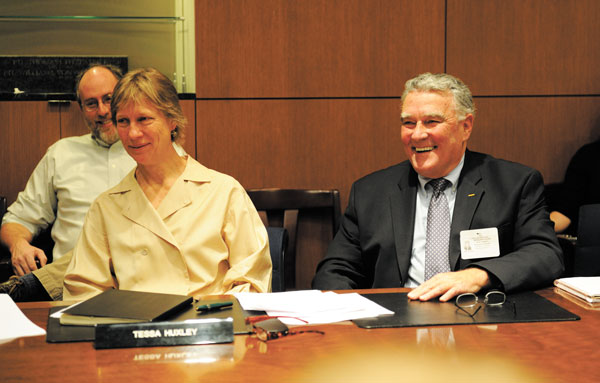The results of a new study for potential uses for Pier 40 were recently released, and are jumpstarting a vigorous discussion about the future of this critical, yet badly deteriorated, structure in the Hudson River Park.
The study was largely done by HR & Advisors and finished up by Tishman/Aecom. It looked at seven different development scenarios, from doing nothing, to The Related Companies’ “Vegas on the Hudson,” to combinations of residential, hotel and office use.
The study found that a mix of residential use — 600 rental units — and a modest-sized, 150-room hotel would be the best scenario in terms of raising revenue for the park while limiting “impact,” as in trips by people and cars to the pier.
The Villager has knowledge of the study, and one possible option shows 600,000 sq. feet dedicated to residential use. The pier’s current, two-story “donut” shed encompasses 770,000 square feet of space; the residential option, with a hotel, would include 925,000 square feet total of enclosed space, including 600,000 square feet of residential. Meanwhile, there would be 510,000 square feet of open space for playing fields — an impressive 80 percent of the pier’s footprint.
The Hudson River Park Trust has been sounding the alarm about the perilous state of Pier 40. In a worst-case scenario, sections of the Houston St. pier’s roof could start collapsing in the next few years, and the 14.5-acre pier could be shut down. In addition, recently 70 percent of Pier 54 has been put off-limits due to deteriorated pilings.
Meanwhile, the Trust, due to a lack of state and city funding, is being forced to spend from its reserve fund, and will soon be running at a deficit.
In short, the Trust needs a use on Pier 40 that will generate at least $10 million in annual revenue for the park, in addition to a developer who will commit to fixing the pier’s roof and pilings, at a total cost of $100 million.
The main issue is that when the Hudson River Park Act was written in 1998, the fear was that the waterfront park would be commercially developed and overwhelmed. So, the act includes restrictions against things like residential housing, hotels and office uses.
Similarly, the Trust isn’t allowed to borrow money, so bonding isn’t permitted. And the lease term for Pier 40 — 30 years — isn’t long enough to make a project there financially feasible for a developer.
And yet, Hudson River Park is supposed to be financially self-sustaining. Pier 40 — along with Chelsea Piers and other “commercial nodes” — is intended to be, in part, a revenue-generating pier. Ironically, the commercial uses the legislation does allow — such as big-box retail and entertainment — are ones the community is adamantly against.
The result has been two past R.F.P.s (“requests for proposals” from developers) that have failed.
The Trust is now saying the Hudson River Park model clearly is “broken,” and that the park act must be changed — and a push is on to make the necessary modifications before the current legislative sessions ends in June.
Assemblymember Richard Gottfried is keeping an open mind, given the park’s financial plight. But Assemblymember Deborah Glick is taking a more cautious and skeptical approach. Glick says that under the park act, a public hearing, with 30 days’ notice, must be held, followed by 30 more days for public input. Glick tells us she fears the Trust is trying to “stampede and frighten everyone” into accepting residential use.
Clearly, the changes in question — longer lease, more allowable uses, bonding authority — won’t happen unless Glick is assured it’s the right thing to do. We hope that the Trust and community activists will be able to sway her opinion.
Again, residential would create the most revenue, least impact and most field space. It’s time that everyone keep an open mind about this process.


















